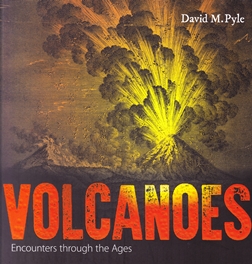 Volcanoes - An exhibition at the Weston Library, Bodleian Libraries, Oxford, 10 February-21 May 2017
Volcanoes - An exhibition at the Weston Library, Bodleian Libraries, Oxford, 10 February-21 May 2017
Anyone interested in the history of volcanoes will have seen reproductions of certain classic images in books. For example, a black-and-white slice through the Earth anatomising a hellish central fire feeding heat through convoluted channels to other internal fires that are themselves connected to erupting volcanoes located around the crust of the planet. This vision is from the Jesuit polymath Athanasius Kircher’s Mundus subterraneus, published in 1664. Then there are the poetically coloured views of a paroxysmal eruption of Vesuvius in 1779 as seen from Naples, with operatically posed spectators. Painted by Pietro Fabris, they form a supplement to the diplomat and pioneering volcanologist William Hamilton’s Campi Phlegraei [Flaming Fields], a collection subtitled Observations on the Volcanoes of the Two Sicilies, published in 1776.
More scientifically, there is the South American explorer Alexander von Humboldt’s cross-section through the highest mountain in Ecuador, the quiescent, snow-topped, stratovolcano Chimborazo, accompanied by its Andean neighbour, the smoking Cotopaxi, silhouetted against a blue sky and flanked on either side by elaborate data showing—for each volcanic elevation—the temperature, humidity, atmospheric pressure, animals and plants. This “
Géographie des plantes équinoxiales” was published as an enormous colour foldout in Humboldt’s
Essai sur la géographie des plantes, in 1805.
However, few of us will have sought out the originals of these images. These are now on display, along with many other first editions and manuscripts and a few non-literary items (such as a modern volcanologist’s fire-proof suit), in a smallish yet inspiring exhibition, Volcanoes, at the Bodleian Library, curated by David Pyle, professor of earth sciences at Oxford. Most material comes from the Bodleian, which means that the exhibition cannot claim to be comprehensive; for instance, Japanese volcanoes receive relatively little coverage. (The book of the exhibition (pictured) will receive a separate review in due course.)
There are some surprises. Perhaps the most charming is the earliest-known manuscript illustration of a volcano. Cartoonish but easily recognisable, it appears in a 15th-Century life of the Irish monk, St Brendan, who voyaged across the North Atlantic in the 6th Century with companions and encountered two volcanic islands. “As they passed by, a savage rushed to the shore, carrying tongs with a burning mass of slag of great size and intense heat.” Whereas the most intriguing is an indecipherable coal-black papyrus scroll from the library of a private house in Herculaneum, carbonised by the most famous eruption of Vesuvius, in AD 79, discovered in the 18th Century during the beginning of archaeology, and presented to the Bodleian by George, Prince of Wales, in 1810. Increasingly technologically sophisticated efforts to read such scrolls continue, with varying success.
Reviewed by Andrew Robinson - author of Earth-Shattering Events: Earthquakes, Nations and Civilization, Thames & Hudson, 2016